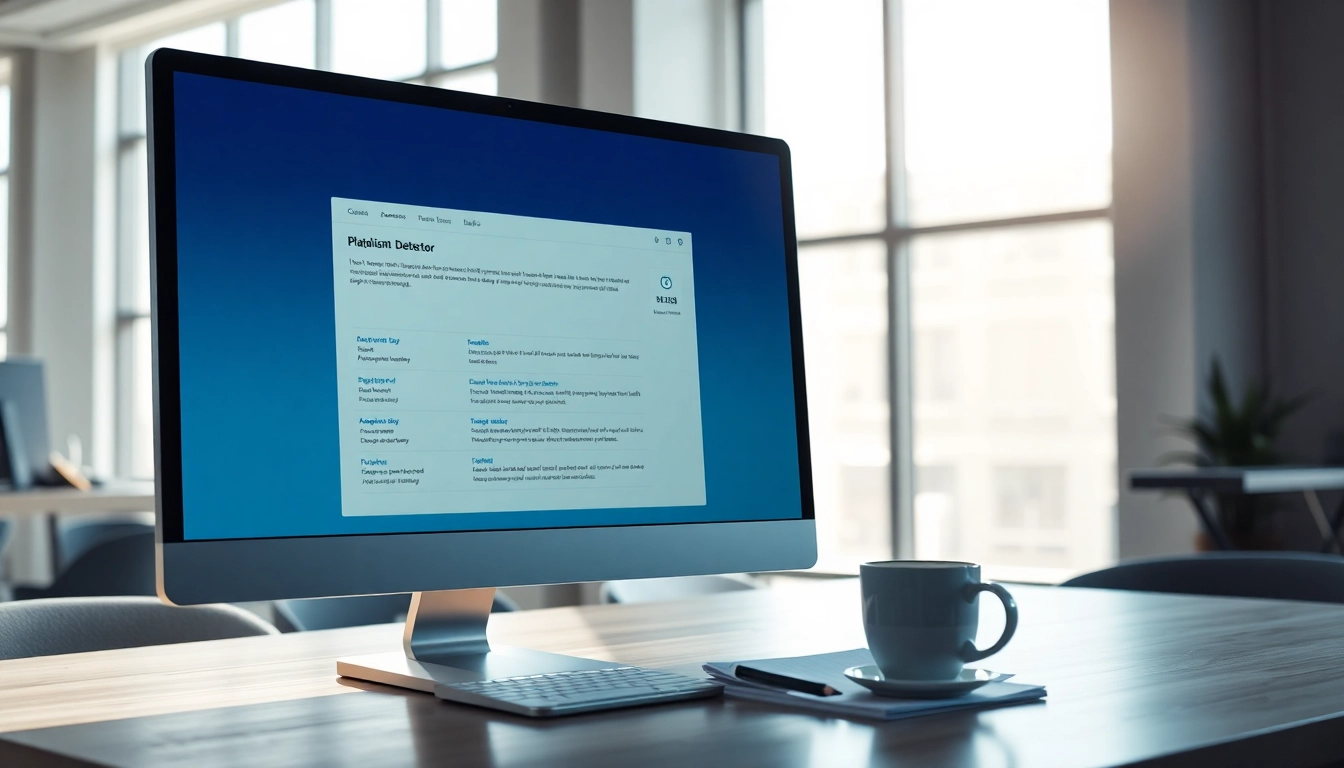Understanding Plagiarism and Its Implications
In a world overflowing with information, the concept of plagiarism has become more pertinent than ever. As students, writers, and professionals engage with content, the risk of inadvertently reusing someone else’s work looms large. Comprehending plagiarism and its implications is crucial for maintaining integrity in academic and professional settings. In this article, we will delve into the meaning of plagiarism, its consequences, the different types of plagiarism detectors available, how these detectors function, and best practices for using them effectively. Additionally, we’ll explore emerging trends in plagiarism detection technology.
What is Plagiarism?
Plagiarism is defined as the act of using someone else’s work, ideas, or intellectual property without proper attribution. This can take various forms, from copying text verbatim to paraphrasing someone else’s concepts and passing them off as one’s own. Not limited to written work, plagiarism can also occur in art, music, software code, and more. In academic settings, it often encompasses
- Direct plagiarism: Copying text word-for-word from a source without citation.
- Self-plagiarism: Reusing one’s previous work without acknowledgment.
- Accidental plagiarism: Failing to cite sources correctly or misrepresenting where ideas originated.
The Consequences of Plagiarism
Engaging in plagiarism can result in severe repercussions, both academically and professionally. The consequences may vary depending on the context, but they often include:
- Academic Penalties: Institutions typically impose severe ramifications on students caught plagiarizing, which could range from failing the assignment to expulsion.
- Loss of Reputation: For professionals, being caught plagiarizing can tarnish one’s reputation, leading to job loss, damaged credibility, and potential legal consequences.
- Financial Consequences: Legal actions may result in monetary fines if intellectual property rights are violated through plagiarism.
- Resource Reputation Impacts: Websites and publishers may lose credibility if they fail to catch plagiarism in submitted articles or works.
Types of Plagiarism Detectors Available
Given the severity of plagiarism’s consequences, utilizing a plagiarism detector has become essential for writers and students alike. Various types of detectors are available, each with its unique features:
- Software-Based Detectors: These programs offer offline capabilities and are typically more robust, allowing users to upload documents for scanning.
- Web-Based Detectors: Accessible from anywhere, these online tools provide quick checks but may have limitations based on the size of the content examined.
- University-Specific Detectors: Many academic institutions employ subscription services like Turnitin or Grammarly, which are designed to detect plagiarism specifically for academic writing.
How a Plagiarism Detector Works
Understanding the mechanics behind plagiarism detection tools can help users appreciate their importance. By examining the technology and methodologies behind these tools, users can enhance their usage.
Technical Features of Plagiarism Detectors
Most plagiarism detectors utilize a combination of proprietary algorithms and advanced databases to identify similarities across documents. Key features typically include:
- Database Comparison: Detectors access vast databases of academic publications, papers, and web content to identify potential matches.
- AI-Powered Algorithms: Modern detectors often employ AI to improve detection accuracy, analyzing sentence structures and synonyms beyond simple text matching.
- Reporting Tools: Comprehensive reports that highlight copied sections, percentages of originality, and sources for cited materials are standard, allowing users to understand and rectify plagiarism incidences.
AI and Plagiarism Detection
The integration of artificial intelligence in plagiarism detection has profoundly enhanced the accuracy and efficacy of these tools. AI algorithms can analyze not only text similarity but also patterns in writing style and structure. This advancement enables the detection of paraphrased content that traditional keyword-matching techniques might miss.
Furthermore, AI can learn over time. As it analyzes more content, its predictive capabilities improve, becoming more adept at recognizing nuanced linguistic transformations. This is increasingly important as writers become more sophisticated in their attempts to disguise plagiarism.
Limitations of Plagiarism Detectors
While plagiarism detectors are invaluable tools, they are not foolproof. Several limitations warrant consideration:
- False Positives: Some detectors may erroneously flag correctly cited material as plagiarized, leading to unnecessary concerns for the author.
- Limited Database Access: Many free or consumer-level tools have a significantly smaller database than their paid counterparts, potentially missing detected matches.
- Diversity in Writing Styles: Different writing styles and formats can affect the accuracy of detection, sometimes leading to misinterpretations.
Choosing the Right Plagiarism Detector
When selecting a plagiarism detector, several factors should be considered to ensure the tool meets the user’s specific needs.
Factors to Consider When Selecting a Tool
Evaluating a plagiarism detector involves assessing various criteria:
- Accuracy: Look for tools known for their accuracy in detecting both verbatim and paraphrased content.
- Database Size: Consider the size and scope of the detector’s database. A larger database may yield more thorough results.
- User Interface: A user-friendly interface contributes significantly to the overall experience and efficiency in using the tool.
- Reporting Features: Detailed reporting can provide insights into the originality of the content and suggest improvements.
Comparison of Popular Plagiarism Detectors
Several plagiarism detection tools are widely recognized in the market. Comparing features, pricing, and user reviews can help users identify the most suitable option:
- Grammarly: Known for its powerful writing enhancement features, Grammarly also includes a robust plagiarism detection tool that scans billions of web pages and academic publications.
- Turnitin: Predominantly used in academic settings, Turnitin offers comprehensive text comparisons, a large database, and provides feedback on writing quality.
- Copyleaks: This tool focuses on detecting duplicate content across the internet and coding language inspections, making it a favorable choice for technical writers and content creators.
Free vs. Paid Plagiarism Detection Services
Users often face the dilemma of choosing between free and paid plagiarism detection services. Free services may suffice for casual users or small-scale projects, but ultimate reliability typically leans towards paid options. Paid services generally offer:
- Access to extensive databases.
- Advanced features like AI detection and detailed reporting.
- Continuous updates to databases, ensuring enhanced accuracy over time.
Best Practices for Using a Plagiarism Detector
Maximizing the effectiveness of a plagiarism detector involves adopting certain best practices during the writing process and while utilizing the tool itself.
How to Optimize Your Writing for Detection
Optimizing your writing can ensure that your work stands out as original while still effectively utilizing external sources. Consider the following:
- Paraphrasing: Rewrite ideas in your own words and style, maintaining the original meaning while avoiding direct copying.
- Include Citations: Always provide proper citations for quotations and borrowed ideas, adhering to the required academic or professional formatting style.
- Use Quotes Sparingly: While quoting may be necessary at times, excessive reliance on quotes can increase the likelihood of plagiarism detection tools flagging your work.
Understanding and Interpreting Reports
After running your document through a plagiarism detector, you will receive a report. Understanding this report is crucial for taking appropriate actions:
- Match Highlighting: Identifying sections that have been flagged as plagiarized helps in addressing those parts directly.
- Originality Percentage: The report may provide a percentage that indicates the level of originality. Familiarize yourself with what constitutes acceptable originality levels in your context.
- Source Links: Utilize the links provided in the report to analyze the original sources and ensure correct attribution wherever necessary.
Improving Originality in Your Work
Ultimately, the best way to avoid plagiarism is to cultivate originality. Here are some strategies to enhance your unique voice in writing:
- Develop Your Voice: Practice writing regularly and develop your unique style; this makes your work more recognizable as your own.
- Engage with the Material: Understand the content you are working with. Engage deeply with research, allowing you to internalize and then express ideas in your own ways.
- Seek Feedback: Collaborating with peers for feedback can provide insights on how original your work appears and where improvements can be made.
The Future of Plagiarism Detection Technology
As technology evolves, so do the approaches to detecting plagiarism. Keeping an eye on new developments can ensure you leverage the most effective tools available.
Emerging Trends in Plagiarism Technology
The field of plagiarism detection is witnessing the integration of various innovative methodologies:
- Machine Learning Models: Advanced learning algorithms are being developed that can detect even subtler forms of plagiarism and adapt to new writing styles.
- Real-Time Detection: With ongoing innovations, some tools are moving towards real-time detection mechanisms that can assist users while they write.
- Multi-Language Detection: As globalization increases, so does the demand for tools capable of identifying plagiarism in multiple languages.
The Role of Educational Institutions
Educational institutions act as pivotal players in promoting plagiarism awareness and establishing a culture of academic integrity. By providing resources, training, and access to plagiarism detection tools, they can help students understand the importance of originality.
Integrating Plagiarism Detection in Writing Courses
By integrating plagiarism detection methodologies into writing courses, educational systems can emphasize the value of originality and proper citation practices. Such initiatives will empower students to take ethical approaches in their writing and musical creations moving forward.



